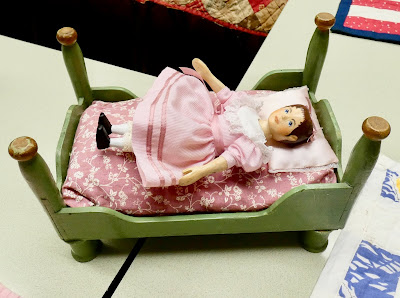These three dolls bundled up in winter clothes greeted members at the refreshments table.
Member Elaine Jackson gave a program on doll quilts.
She explained that originally bed covers, for both people and dolls, were woven.
However, people learned to make warmer coverings by stitching together woven fabric, sometimes with a layer of padding for added warmth.
For pieced quilts, individual scarps of fabric were stitched together. This was a thrifty way to make use of scraps, old clothing, and other material.
Often the fabric was pieced together in a geometric pattern.
In crazy quilts, however, odd-shaded pieces of fabric were fitted together in an apparently random pattern. A wide variety of fabrics, often embellished with embroidery or lace, was used.
Crazy quilts were often made out of bits of fabric and scraps that had a special meaning to the maker or the recipient. Elaine made this crazy quilt for herself.
Another method was to tie together layers of woven fabric. This "yo-yo" quilt is an example of such a tied quilt.
Two wooden "Hitty" dolls from Elaine's collection rest on beds covered with miniature quilts.
This vintage doll bed was made out of an old wooden cigar box with posters made out of wood clothespins and feet from wooden spools.
This antique china head doll rests on a quilt made by Elaine's grandmother from pieces of family clothing. The antique doll bed is also an heirloom and was once used as a magazine rack.
Elaine brought many examples of quaint and colorful doll quilts.
Other members also brought quilts to share. These examples belong to Myrna Loesch. The quilt on the doll bed and doll bed itself are family heirlooms.
Two tiny cribs and a miniature quilt sit atop a crib quilt.
This doll quilt was pieced together from "tobacco felts." These small printed felt or flannel pieces were made in a wide variety of designs and sold with cigarette, cigar, or other tobacco products in the early 1900s as premiums. Larger pieces could be obtained by saving and sending in tobacco coupons or boxtops.

























No comments:
Post a Comment